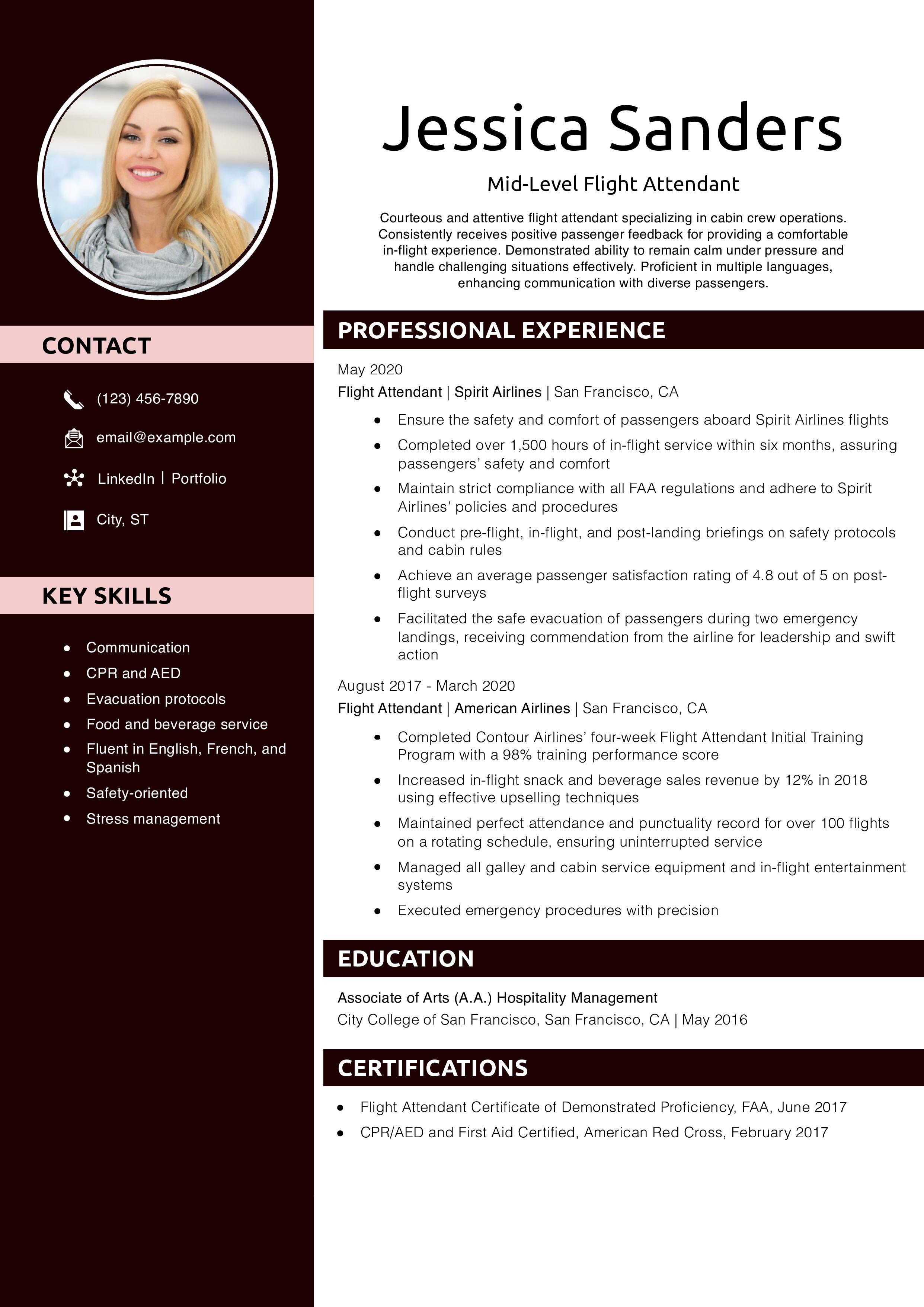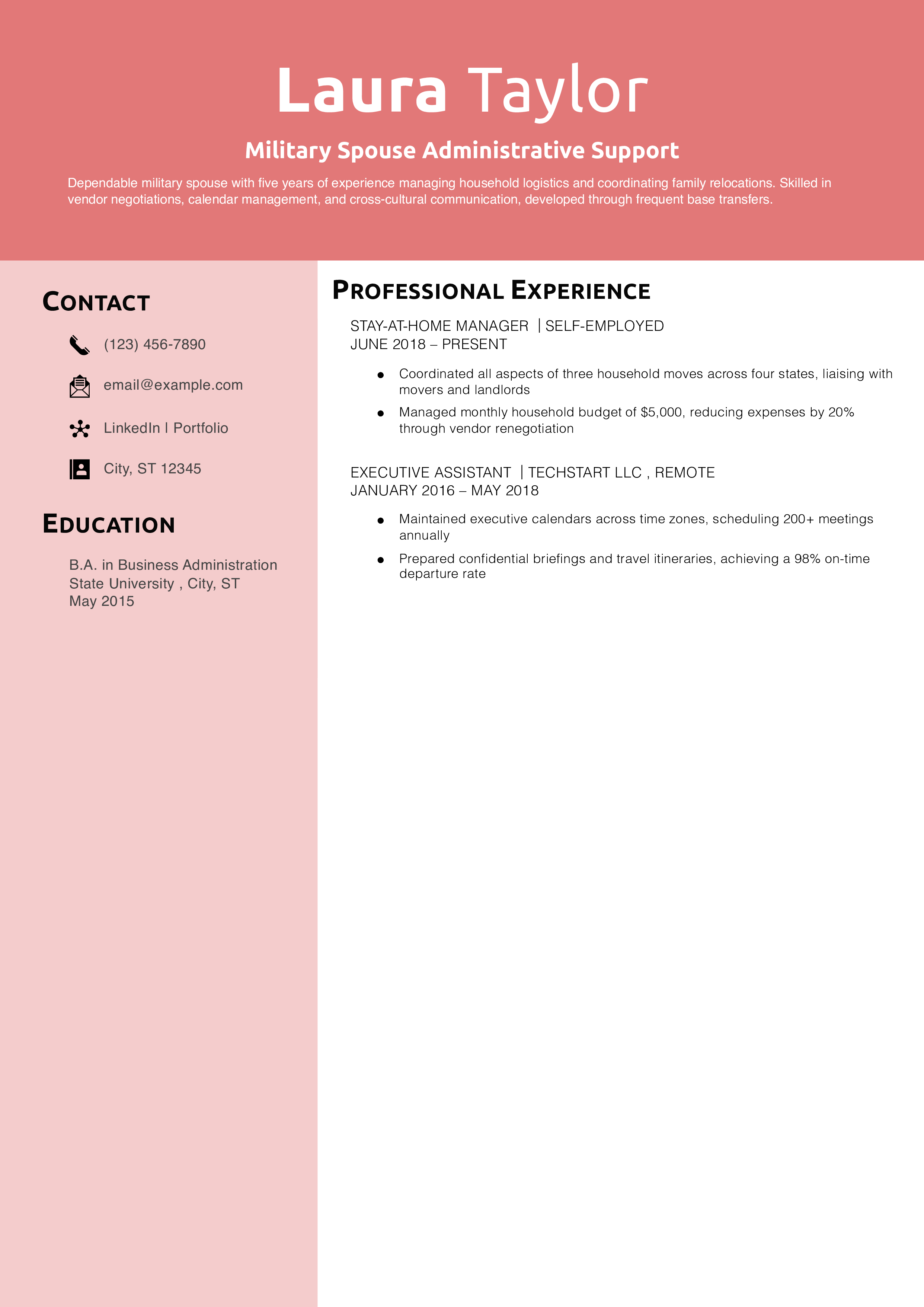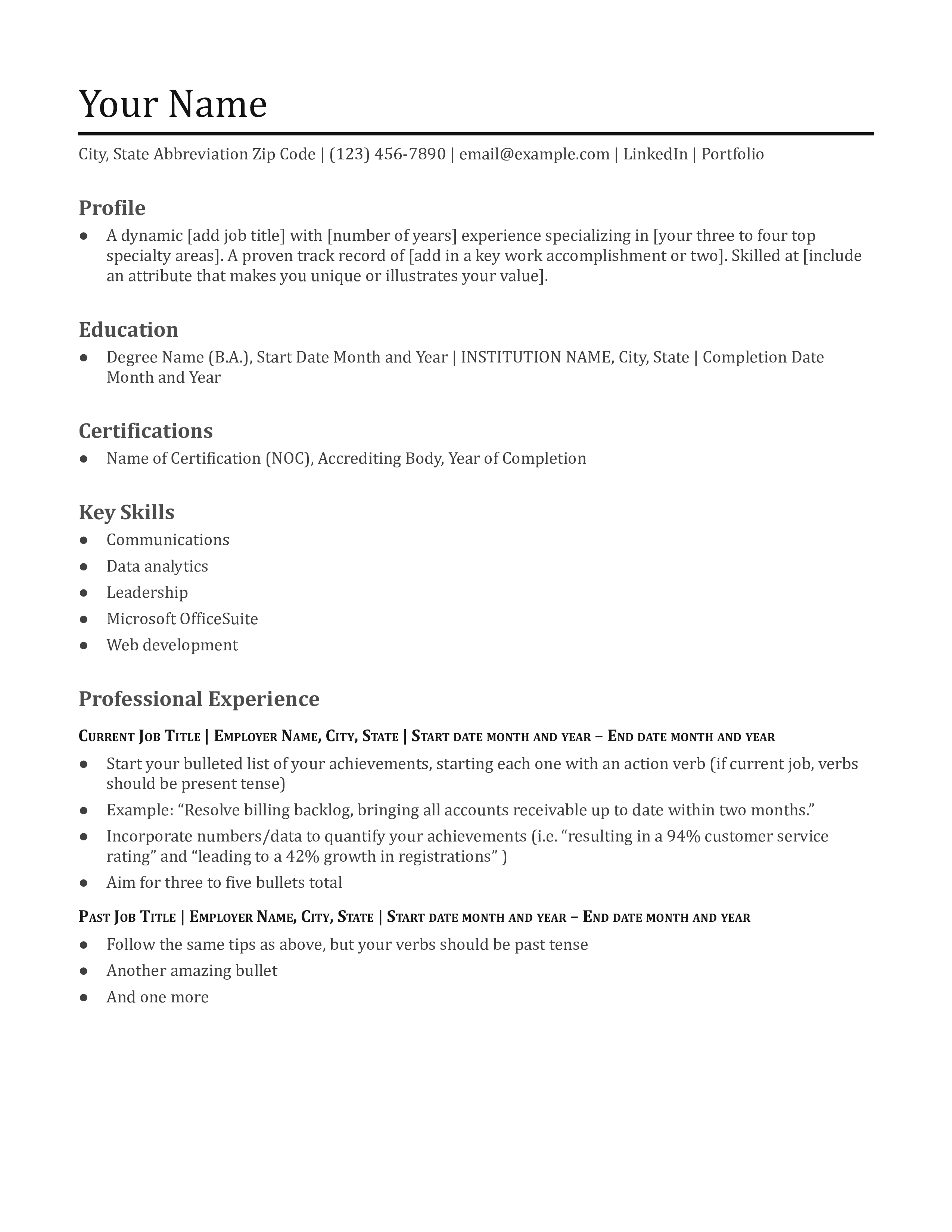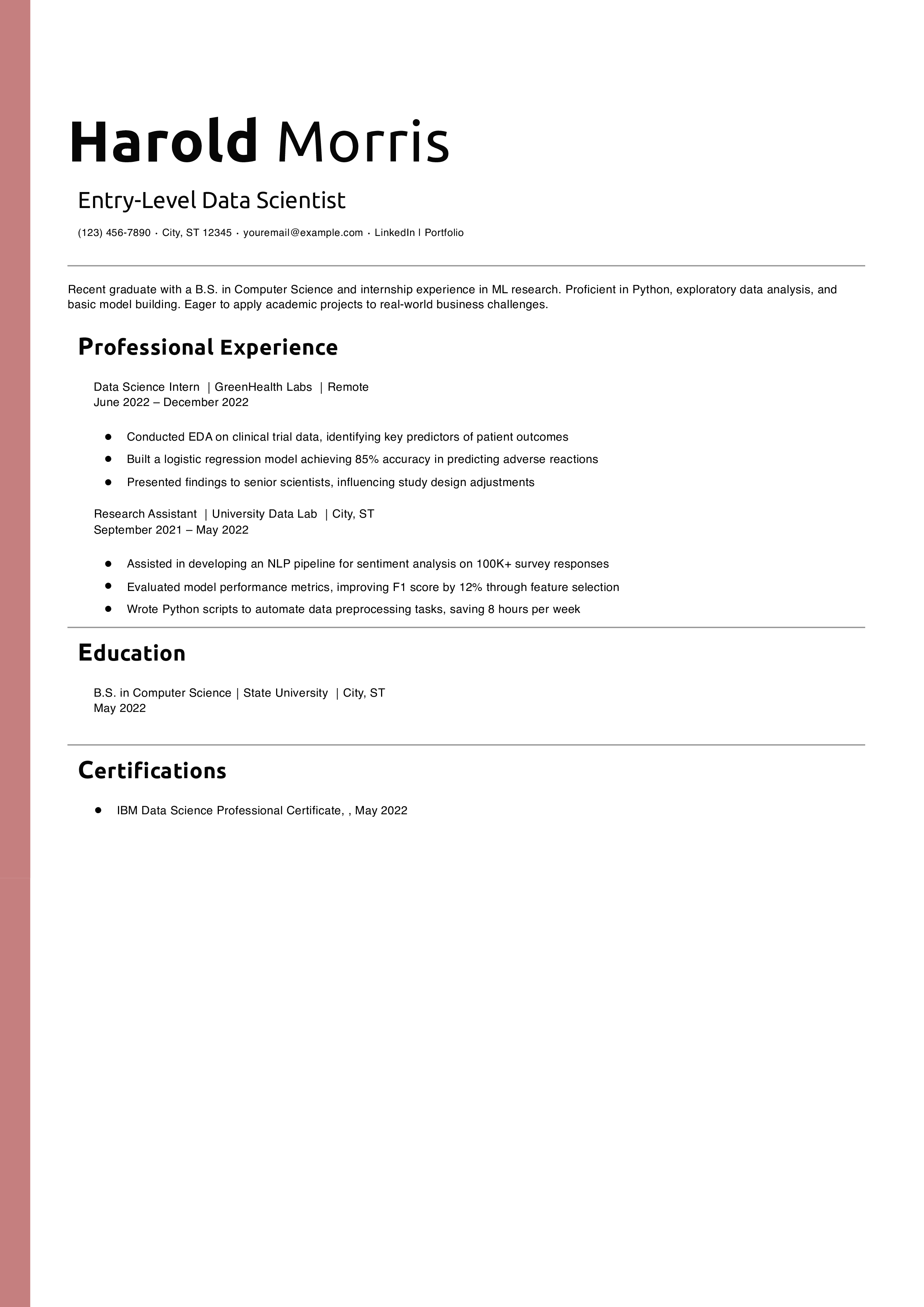As a pilot, you’ve invested hundreds of hours in training and education to handle the demands of flight. Your resume must show hiring managers you can navigate all situations and conditions safely as you pilot their aircraft. In this guide, we’ll provide strategies to help you write a pilot resume that secures a spot in the cockpit and prepares your next career move for takeoff.
Key takeaways:
- Highlight flying time: Your total flying time and flight specializations should be among the first things on your resume.
- Include quantifiable accomplishments: Incorporate numbers when describing past contributions such as safety records, improvements, and number of successful flights.
- Use industry-specific keywords: Employers often use Applicant Tracking Systems (ATS), and incorporating keywords from the pilot job description will help your resume reach a hiring manager.
Most Popular Pilot Resumes
Commercial Pilot Resume Example
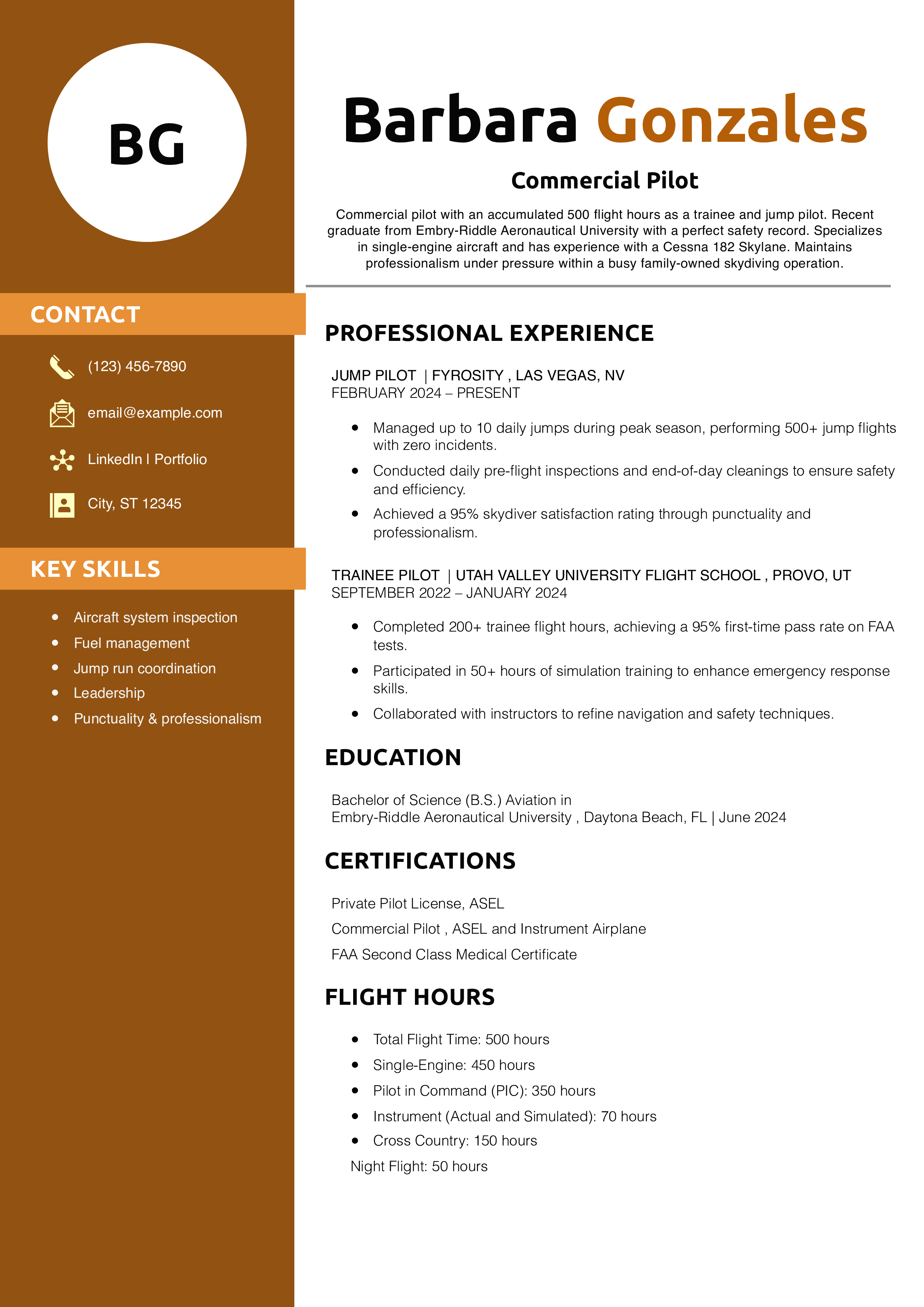
Why This Resume Is a Great Example
This resume emphasizes flight hours and safety metrics—critical for any pilot role—and showcases the candidate’s ability to manage a high-pressure jump schedule, underscoring reliability and attention to detail.
Key Tips
A strong structure—starting with a profile, then experience, skills, and education—lets recruiters quickly gauge your qualifications. Check out Best Resume Formats for more guidance.
Airline Transport Pilot Resume Example
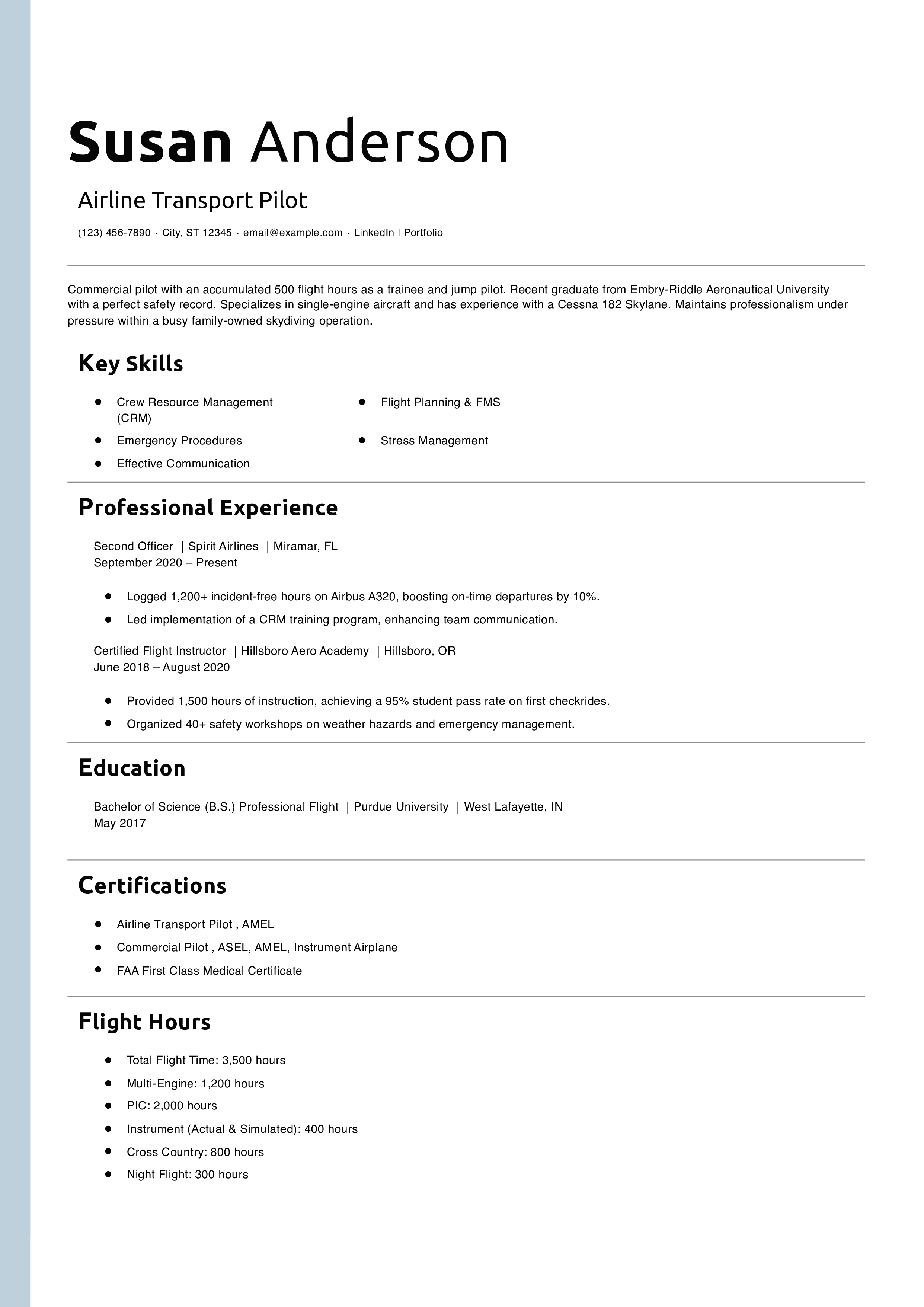
Why This Resume Is a Great Example
It quantifies flight hours and highlights safety and teaching experience, key for senior pilot roles, while demonstrating leadership in CRM.
Key Tips
Lead with your strongest metrics (flight hours, safety record) and group related certifications. For more on showcasing your versatility, see Skills to Put on a Resume.
Chief Pilot Resume Example
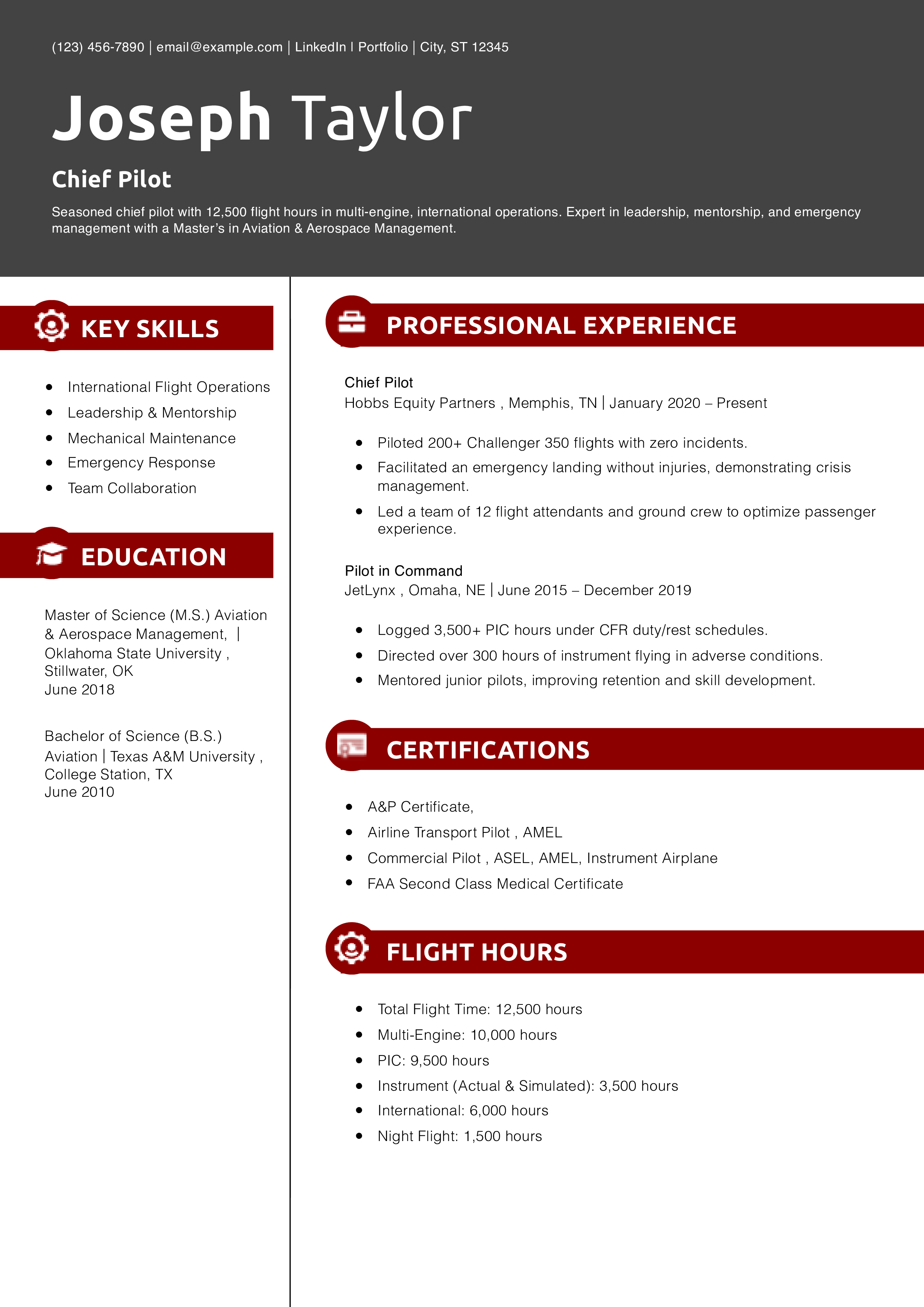
Why This Resume Is a Great Example
It blends exceptional flight metrics with leadership achievements, crucial for C-suite aviation roles, and underscores both technical and people skills.
Key Tips
Highlight crisis management and mentorship success. For a deep dive on structuring executive resumes, see Best-Looking Resumes.
Corporate Pilot Resume Example

Why This Resume Is a Great Example
This resume quantifies high-stakes international flights and emphasizes executive-level coordination, demonstrating reliability for corporate environments.
Key Tips
Focus on stakeholder communication and efficiency gains. For more on tailoring your objective, see Resume Objective Examples.
Entry Level Pilot Resume Example
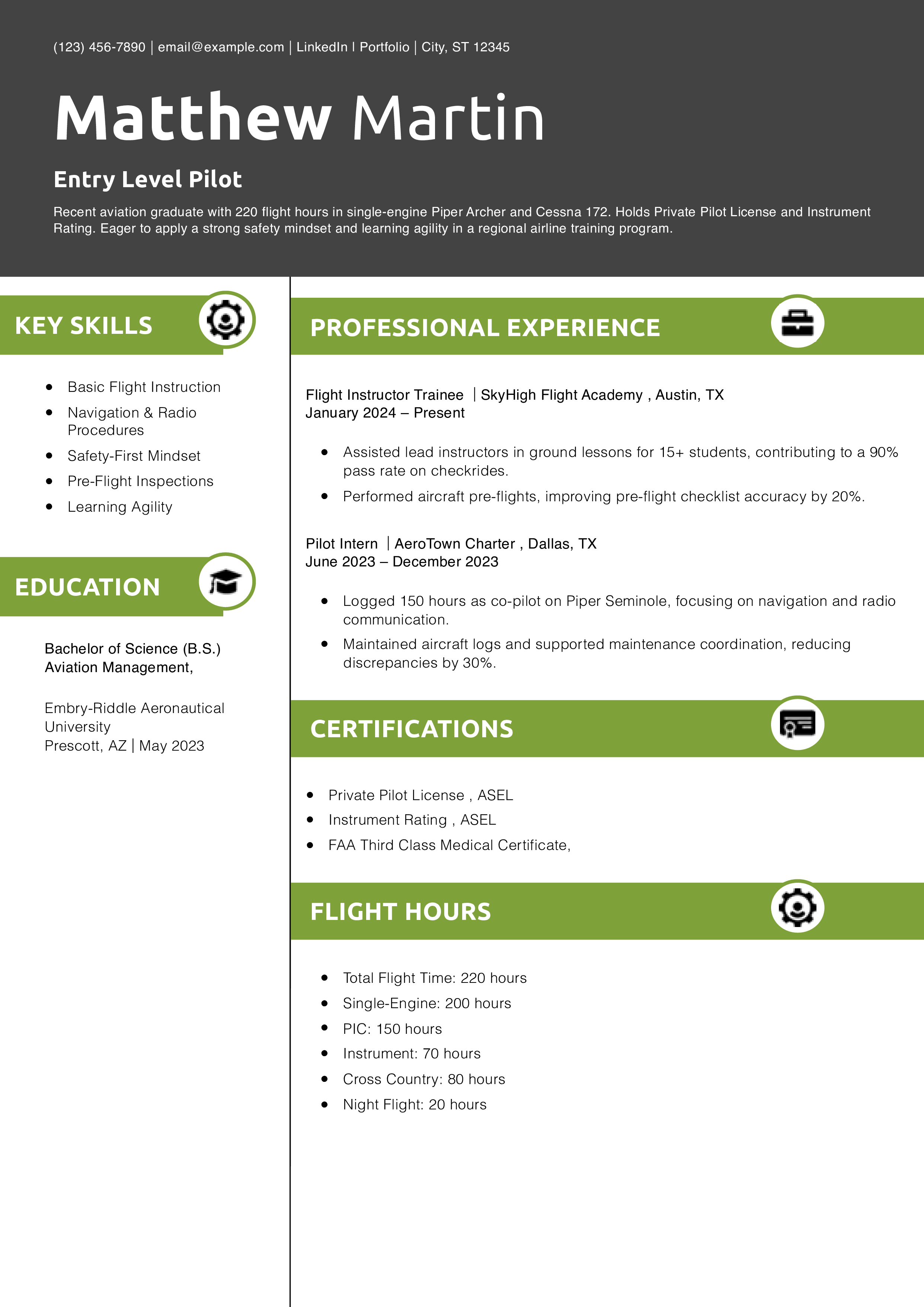
Why This Resume Is a Great Example
It highlights early flight hours and training achievements, underscoring the candidate’s readiness and commitment to safe operations.
Key Tips
Showcase your instructional experience and metrics. For tips on highlighting skills, see Skills to Put on a Resume.
Student Pilot Resume Example

Why This Resume Is a Great Example
By listing initial flight hours and ground-support experience, this resume shows the candidate’s proactive engagement in aviation and foundational skills.
Key Tips
Emphasize your rapid learning and safety record. For more on resume length, see How Long Should a Resume Go?.
Private Pilot Resume Example
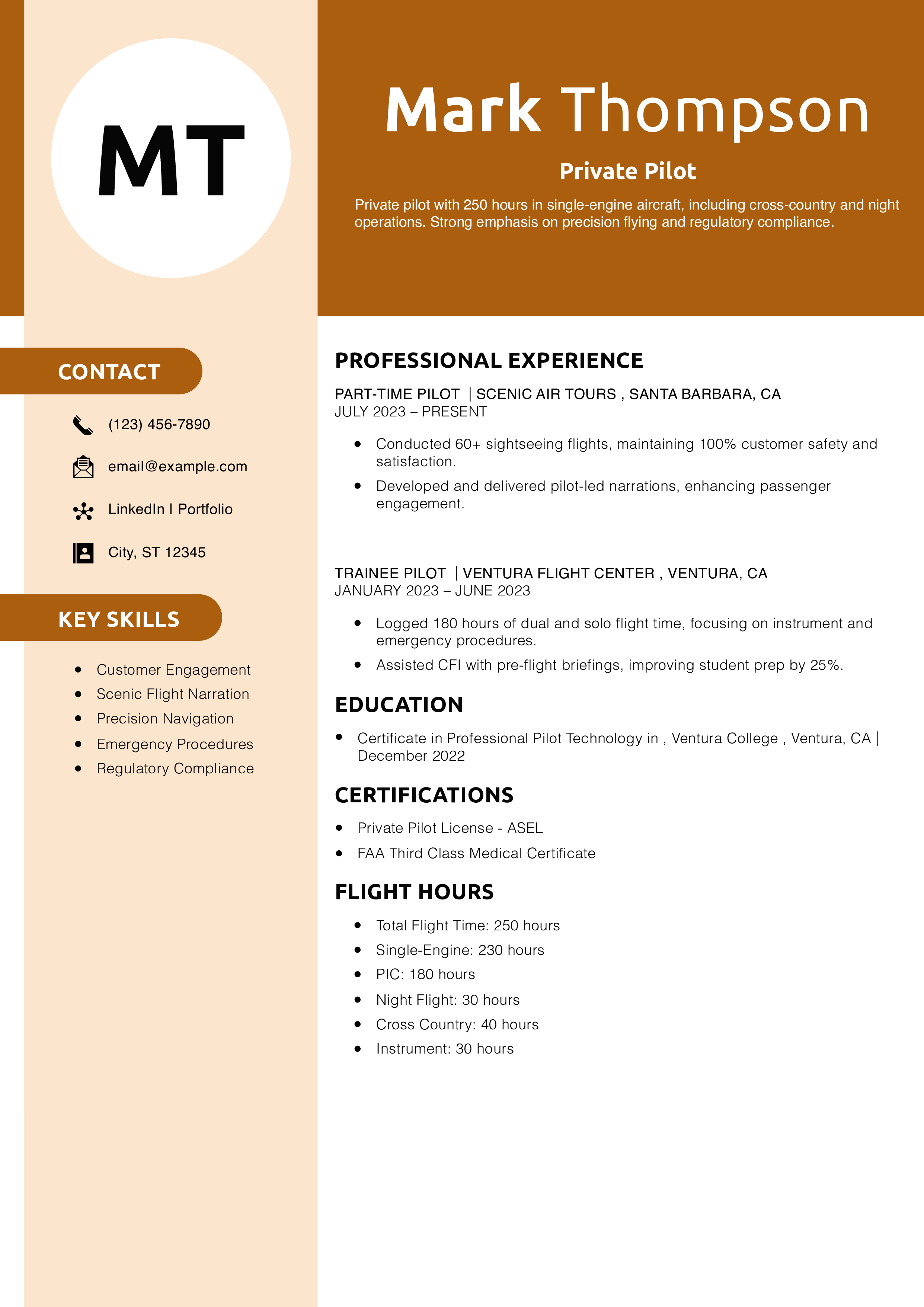
Why This Resume Is a Great Example
It blends flight proficiency with customer-service metrics—important for tour operations—while showcasing clear career progression.
Key Tips
Combine technical hours with soft-skill examples. Learn more about formatting your summary in How to Write a Resume Summary.
Helicopter Pilot Resume Example

Why This Resume Is a Great Example
It quantifies both tour and EMS missions, highlighting customer satisfaction and lifesaving metrics.
Key Tips
Emphasize your safety record and mission metrics. For guidance on formatting objectives, see Resume Objective Examples.
Flight Instructor Resume Example

Why This Resume Is a Great Example
It emphasizes instructional outcomes and curriculum improvements that drive student success.
Key Tips
Highlight your training metrics and curriculum design. For more on showcasing skills, see Skills to Put on a Resume.
Test Pilot Resume Example
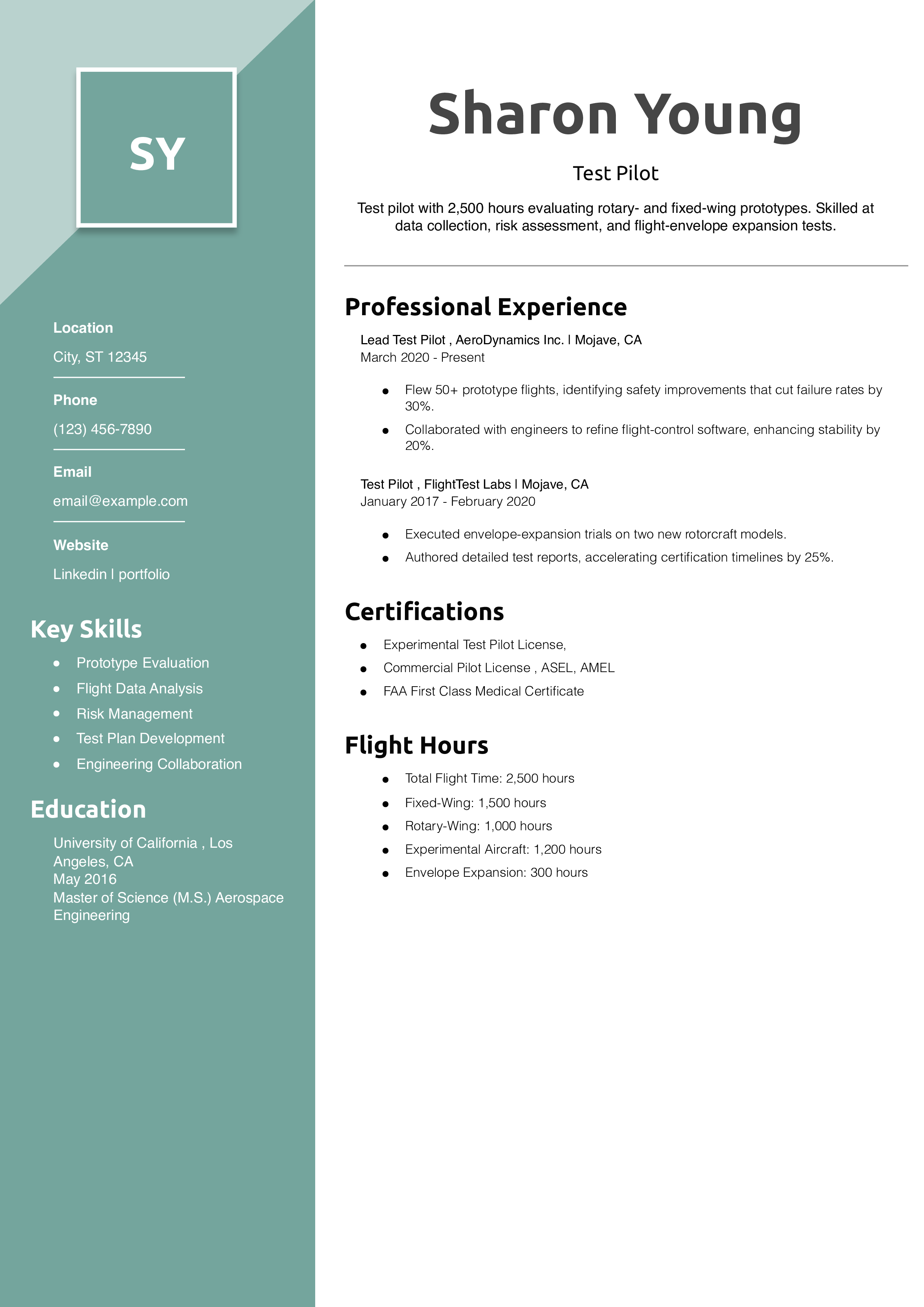
Why This Resume Is a Great Example
It quantifies reductions in failure rates and certification timelines, showing impact on development cycles.
Key Tips
Use your test metrics and data-driven achievements. Learn more about reverse-chronological order in Best Resume Formats.
Medical Evacuation Pilot Resume Example
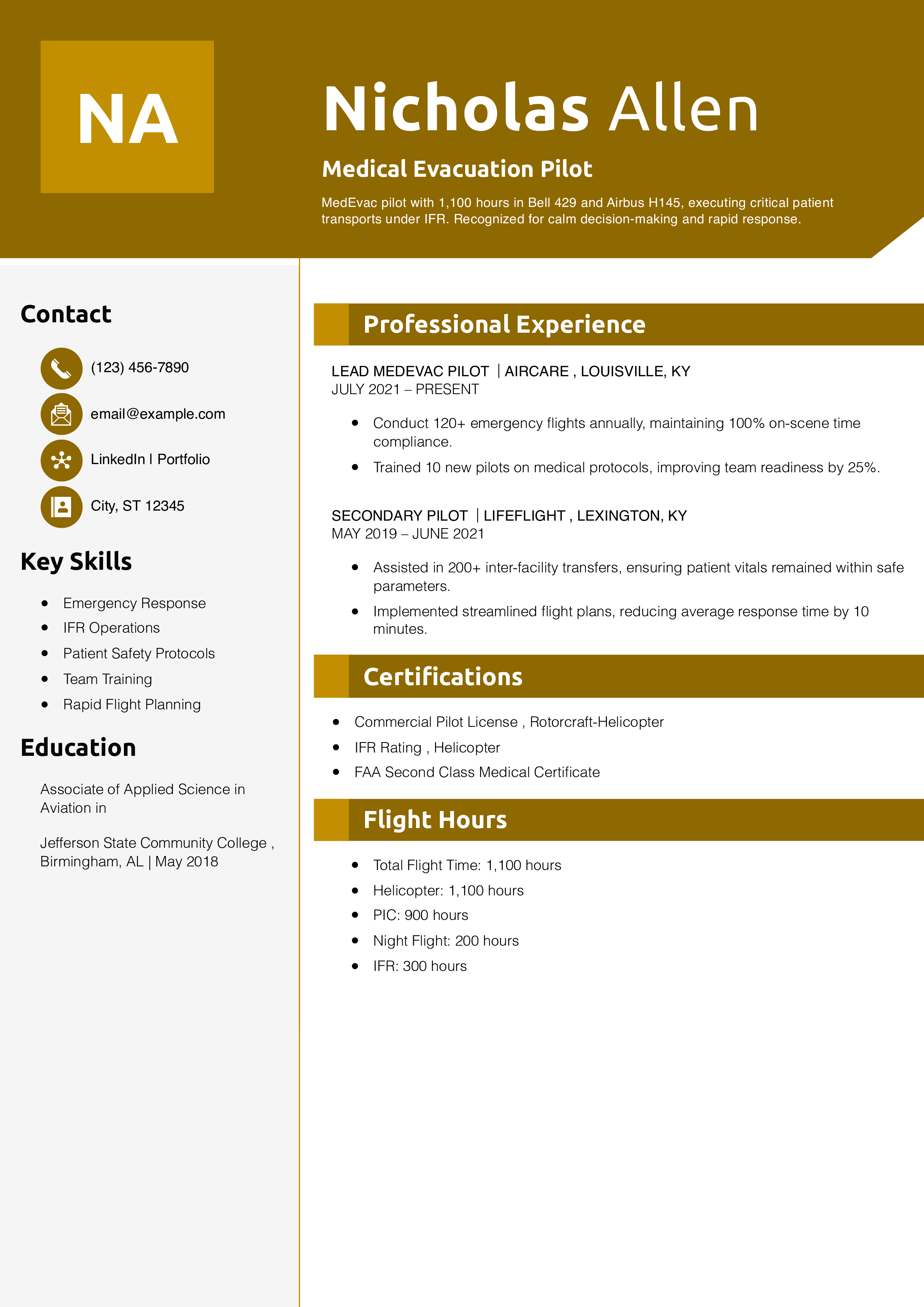
Why This Resume Is a Great Example
It highlights critical lifesaving metrics and training contributions, showcasing mission readiness.
Key Tips
Detail your emergency response metrics. For insights on filling sections, see What to Put on a Resume.
Search and Rescue Pilot Resume Example
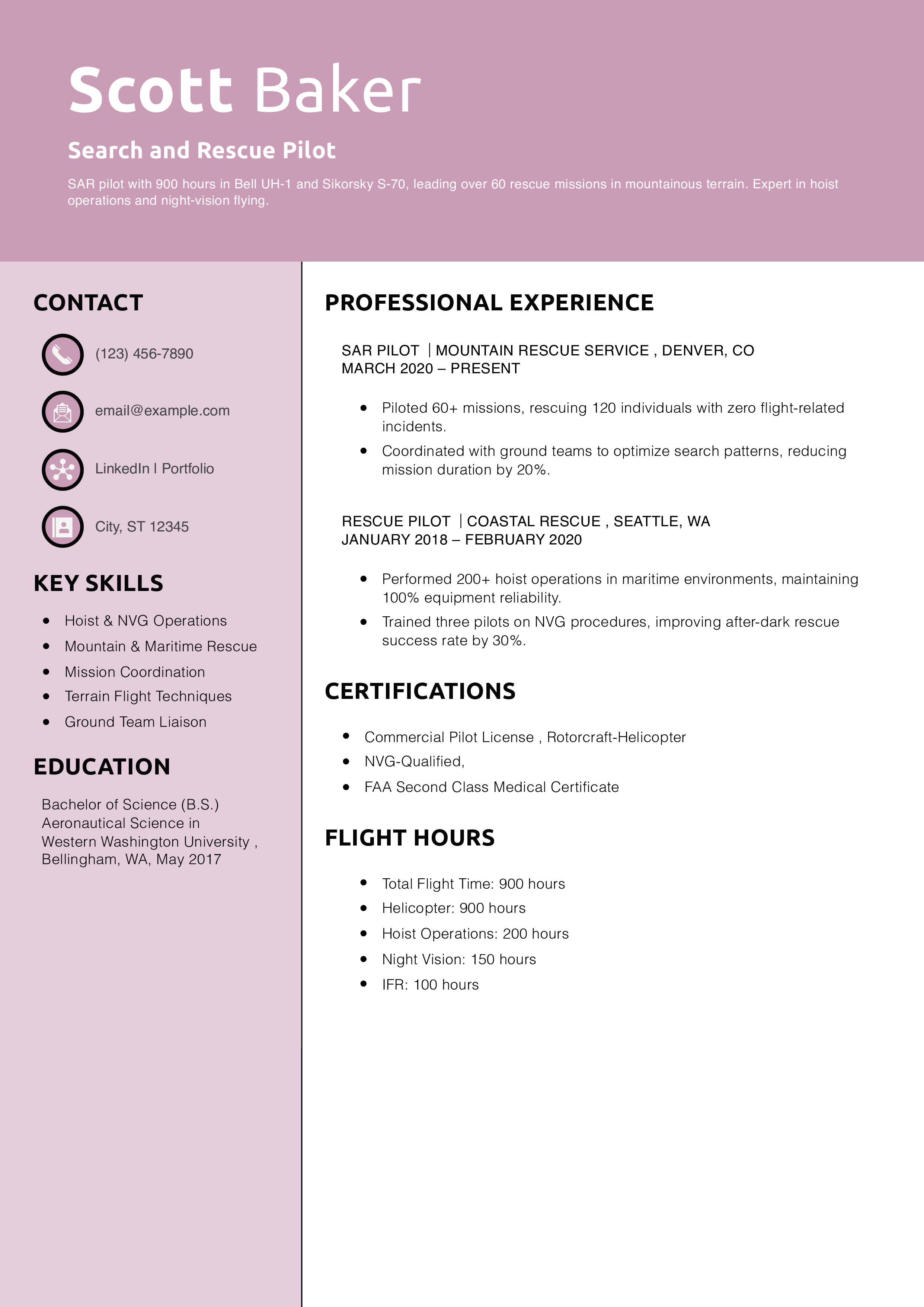
Why This Resume Is a Great Example
It quantifies lives saved and improvements in mission efficiency, underlining operational success.
Key Tips
Include your specialized equipment qualifications. To tailor your profile, see How to Write a Convincing Resume Profile.
UAV Pilot Resume Example

Why This Resume Is a Great Example
It ties UAS metrics to actionable insights—yielding gains and defect detection—showing tangible ROI.
Key Tips
Highlight your regulatory credentials and mission outcomes. For more on bullets, see How to Use Bullet Points on a Resume Effectively.
Seaplane Pilot Resume Example

Why This Resume Is a Great Example
It pairs amphibian-specific hours with customer-satisfaction metrics, ideal for charter operators.
Key Tips
Quantify passenger ratings and turnaround improvements. For profile guidance, see Resume Personal Statement Examples.
Offshore Pilot Resume Example

Why This Resume Is a Great Example
It demonstrates offshore reliability and payload improvements, critical for oil-rig support.
Key Tips
Detail regulated approvals and route optimizations. For more on lists, see Work Experience on a Resume.
Corporate Pilot Resume Example

Why This Resume Is a Great Example
It highlights international flights and time-saving optimizations, key for high-end charter clients.
Key Tips
Quantify your on-time performance and safety record. For advice on structuring your experience, see Best Resume Formats.
Junior Pilot Resume Example

Why This Resume Is a Great Example
It clearly shows entry-level flight hours and hands-on training achievements, ideal for junior roles.
Key Tips
Emphasize your training hours and safety contributions. Learn more about crafting objectives at Resume Objective Examples.
Aspiring Pilot Resume Example
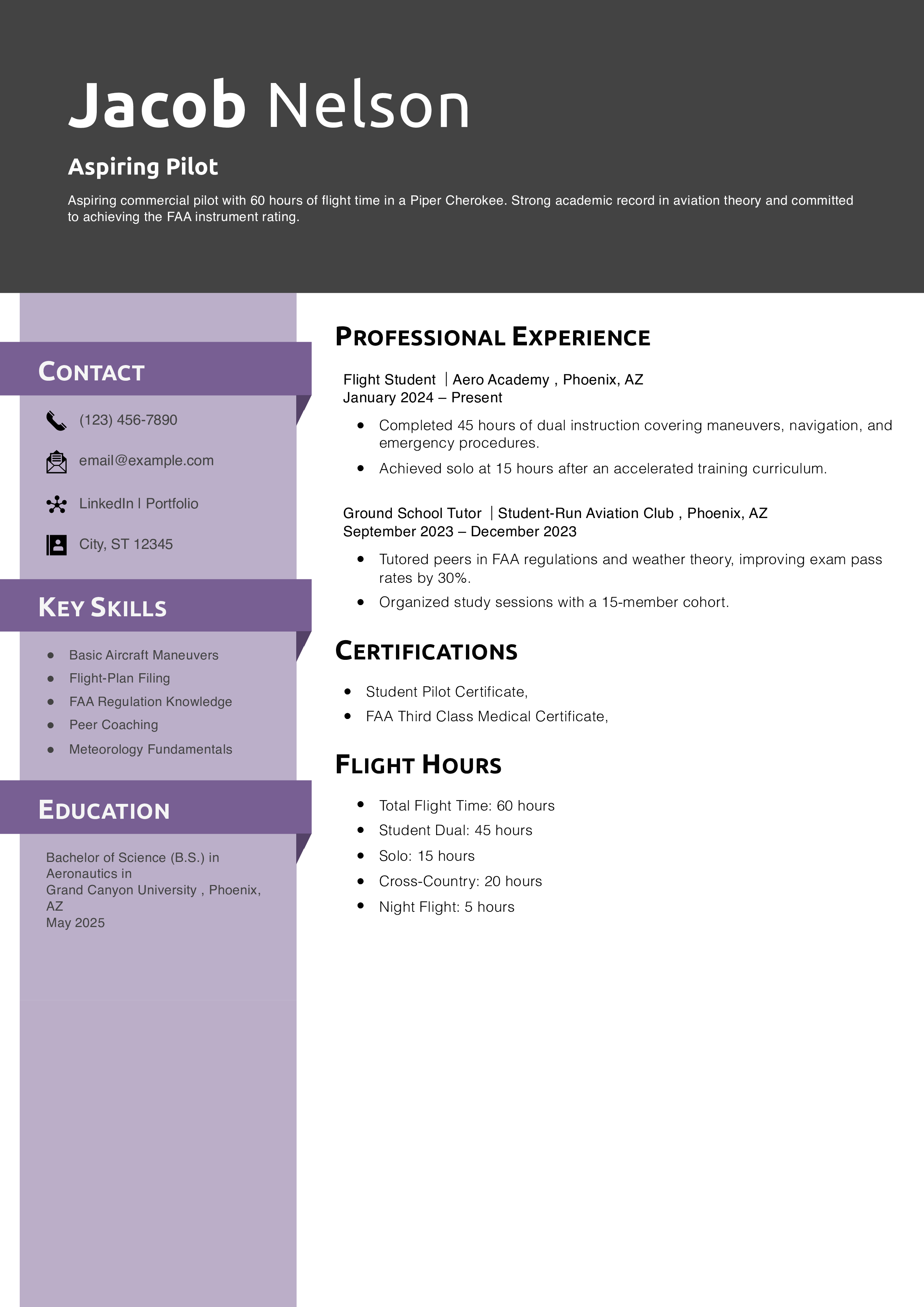
Why This Resume Is a Great Example
It highlights rapid solo achievement and peer-teaching impact, key for student-pilot promotions.
Key Tips
Showcase your ground-school leadership. For insights on summaries, see How to Write a Resume Summary.
Private Cross-Country Pilot Resume Example
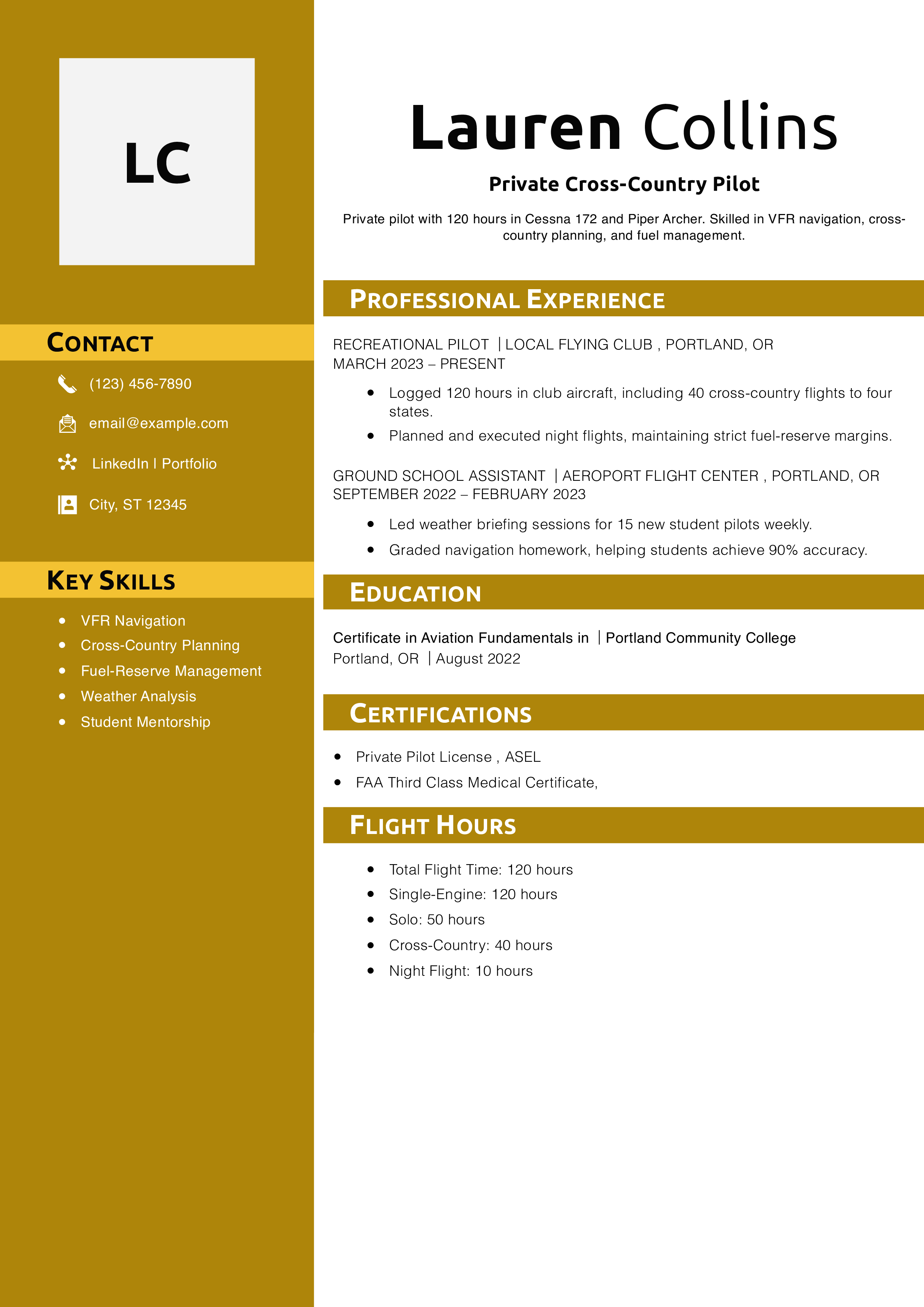
Why This Resume Is a Great Example
It quantifies cross-country hours and mentorship roles, valuable for club-pilot positions.
Key Tips
Detail your navigation and fuel-management achievements. For more on structuring, see Best Resume Formats.
Airline Pilot Resume Example

Why This Resume Is a Great Example
It highlights leadership in mentorship and metrics on punctuality, which is crucial for carriers.
Key Tips
Quantify your on-time rates and training contributions. For insights on bullet usage, see How to Use Bullet Points on a Resume Effectively.
Pilot Text-Only Resume Examples and Templates
How To Write a Pilot Resume Example
Using a premade resume template is the best way to establish a professional, well-structured document. Your pilot resume should include these sections:
- Contact information
- Profile
- Key skills
- Professional experience
- Education and certifications
1. Share your contact information
At the top of your resume, list your current contact information, including your full name, phone number, email address, location, and a link to your online professional profile. Ensure your information is up-to-date and free of typos to clear the runway for further questions and interviews.
Example
Your Name
(123) 456-7890
[email protected]
City, State Abbreviation Zip Code
LinkedIn | Portfolio
2. Craft a solid profile with a summary of your pilot qualifications
A pilot resume profile is a summary of your career that sets the trajectory for the rest of your document. It should include your years in the field, how many hours you’ve flown, and any aircraft or flight specializations that could set you apart from other pilots. Consider what the airline or organization is looking for, and describe what makes you the pilot they need to hire.
For example, if you have experience flying the exact plane model the airline uses, definitely mention it here. Or, if you’re a new pilot looking to land a flight instructor role, let the employer know you’re already certified and ready to fly.
Senior-Level Profile Example
Seasoned chief pilot with over 12,000 hours of total flight time and an extensive background in multi-engine, international operations. Currently pilots a Challenger 350 for a private business. Solid track record of safe and incident-free flights. Leader who has a passion for mentorship and team development. Master’s degree in aviation and aerospace management.
Entry-Level Profile Example
Commercial pilot with 500 flight hours accumulated as a trainee and jump pilot. Recent graduate from Embry-Riddle Aeronautical University with a perfect safety record. Specializes in single-engine aircraft and has experience with a Cessna 182 Skylane. Maintains professionalism under pressure within a busy family-owned skydiving operation.
3. Showcase your pilot experience
This section is like your work history’s pilot logbook. List your most recent positions, along with six to eight bullet points covering key responsibilities and achievements. Describe moments in previous roles relevant to the pilot job you’re applying for, using numbers when you can to quantify your success.
Hiring managers need to know you’re qualified for the job and have the necessary skills and flight time to excel. Get specific with your flight details, listing your hours, safety records, and numbers of flights with previous employers. You can also describe moments beyond time in the cockpit by discussing maintenance, teamwork, and leadership.
Senior-Level Professional Experience Example
Chief Pilot, Hobbs Equity Partners, Memphis, TN
January 2020 – present
- Piloted over 200 private flights in a Challenger 350 super-midsize jet for a business and their family
- Maintain seamless flight operation through continuous liaison with the company’s operating center
- Provide essential A&P support to ensure aircraft is reliable and ready for sudden business trips
- Facilitated an emergency landing without any injuries or significant damage to the aircraft
- Collaborate with a team of 12 flight attendants and ground crew to optimize passenger experience
Entry-Level Professional Experience Example
Jump Pilot, Fyrosity, Las Vegas, NV
February 2024 – present
- Manage a schedule of up to 10 jumps per day during peak season
- Conduct daily pre-flight inspections and end-of-day cleaning to ensure safe and efficient flight operation
- Performed over 500 jump flights and 250 hours with a 100% safety record and zero incidents
- Maintain a focus on fuel management to verify adequate fuel levels for each jump
- Achieved a 95% skydiver satisfaction rating, being consistently recognized for punctuality and professionalism
Resume writer’s tip: Quantify your experience
Metrics offer clear, measurable indicators of your capabilities as a pilot and help to set you apart from other well-qualified candidates. To frame your past responsibilities as accomplishments, use numbers to quantify your experience. Include things like total flight hours, number of flights, improvements in safety and efficiency, or reductions in cost.
Do
- “Conducted over 1,500 hours of flight instruction to students as authorized by Federal Aviation Administration (FAA) regulations.”
Don’t
- “Spent a significant amount of time delivering flight instruction sessions to various students according to the standards and guidelines set forth by the FAA.”
Resume writer’s tip: Tailor your resume for each application
Avoid any turbulence with ATS by including words and phrases from the job description within your pilot resume. This isn’t about copying word-for-word but matching up your own aviation skills and qualifications with those required for the job.
For example, suppose potential employers are looking for pilots who can manage crews during long-haul flights, and you see the phrase “experienced in international routes.” In that case, you would use this exact phrasing somewhere within your resume. You could include it in the profile section or when describing past experiences with global travel.
What if you don’t have experience?
Even without direct, paid experience, you’ve spent time developing technical skills during flight school. Emphasizing relevant coursework, school projects, certifications, flight ratings, and affiliations will demonstrate your fundamental knowledge. Volunteer work or internships within airports and aviation organizations will also prove your practical experience in the industry.
If you don’t have your 1,500 hours of flying time yet to land a job at a regional or major airline, consider earning time as a Certified Flight Instructor (CFI). Many new pilots start as instructors and build up their flight logs this way. Other opportunities have lower flight time requirements and could prove better options to earn your minimum flight time.
4. Outline your education and aviation-related certifications
Your education is the foundation of your aviation abilities. Open the education section by listing the flight school you attended and when you completed your training. If you earned your wings through a degree program, start with your highest degree first. Include the name of the institution, dates of attendance, and any honors you may have received.
List all of your most relevant certifications and ratings closer to the top of your resume. Hiring managers are most interested in what you’re qualified to do and which airplanes you’re legally allowed to operate. If you’re a CFI, airline pilot, commercial pilot, or all three, be sure to highlight this information prominently on your resume.
Education
Template:
[Degree Name]
[School Name], [City, State Abbreviation] | [Graduation Year]
Example:
Bachelor of Science (B.S.) Professional Flight
Purdue University, West Lafayette, IN | September 2013 – May 2017
Certifications
Template:
[Certification Name], [Ratings]
Example:
Commercial Pilot: ASEL, AMEL, and Instrument Airplane
5. Make a list of your pilot-related skills and proficiencies
Whether you’re a commercial or airline pilot, you rely on a vast array of skills to navigate whatever may come your way during a flight. A key skills list demonstrates to potential employers that you have the necessary abilities to handle day-to-day operations. Include both technical know-how and interpersonal qualities that show you’re ready to take command and lead a crew.
Here are some examples of skills you could include on your pilot resume:
| Key Skills and Proficiencies | |
|---|---|
| Aircraft navigation systems | Aviation safety standards and procedures |
| Calm under pressure | Clear communication |
| Critical thinking | CRM |
| Decisiveness | Emergency landing procedures |
| Flight planning | ForeFlight |
| Instrument flight rules (IFR) | Leadership |
| Multitasking | Observant |
| Pre-flight basic systems inspection | Regulatory compliance |
| Risk assessment | Stress management |
| Teamwork and collaboration | Visual flight rules (VFR) |
Resume writer’s tip: Use strong action verbs
To effectively communicate your past aviation duties and accomplishments, use action verbs in your professional experience section. Instead of using redundant first-person language like “I was responsible for,” start each bullet point with an action verb. These words will help hiring managers understand exactly what you did at work and how you actively participated in the role. Use action verbs like those listed below as you write your pilot resume:
| Action Verbs | |
|---|---|
| Analyzed | Communicated |
| Coordinated | Directed |
| Executed | Flew |
| Instructed | Navigated |
| Operated | Piloted |
| Planned | Reacted |
| Supervised | Trained |
| Validated | |
How To Pick the Best Pilot Resume Template
A good resume template for pilots is professional, clean, and simple. Hiring managers must navigate your document and scan it quickly, so choose a design that has a clear structure. Sections should be laid out in a way that makes your resume easy to read and captures your most critical flight details. Avoid graphic-heavy templates and loud colors that could distract the reader.
Frequently Asked Questions: Pilot Resume Examples and Advice
The job outlook for pilots is bright but competitive, with a projected increase in employment of 4% over the next decade. To stand out from the competition, your pilot resume should be tailor-made for the job you're interested in. Every resume you submit must be aligned with the aviation needs of each organization.
Use the job posting as a guide to help you determine the skills, qualifications, and experience an airline or commercial company is looking for in a pilot. To show you meet the role's requirements, match your abilities with those in the job ad and include them in your resume. This will increase your chances of making it through ATS and on to hiring managers.
A Pilot resume example serves as a great starting point to format and structure your resume. Look at how the professional experience is outlined, how skills are listed, and the overall flow of information. Use these examples to inspire your own resume, but make sure to adjust the content to reflect your unique accomplishments and the specific role you're applying for.
A combination format is a good choice for pilots, offering the best of functional and chronological resumes. All of your most essential flight details and certifications are listed at the top of the document for hiring managers to easily capture. Next comes a comprehensive overview of your latest and most relevant work history, rounded out by a key skills list and an education section. This resume format is versatile enough to meet the unique needs of a pilot resume.
Include a cover letter with your resume
Don’t let your resume fly solo — include a cover letter to co-pilot the application process. While the bulk of your professional history lives within your resume, a cover letter offers insight into the finer details of your aviation career and can help you land an interview. This is where you can express your passion for flying and explain why you’re interested in working for that particular employer.
Check Out Related Examples
Resume Templates offers free, HR approved resume templates to help you create a professional resume in minutes. Choose from several template options and even pre-populate a resume from your profile.

